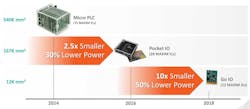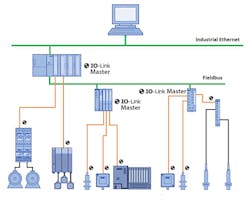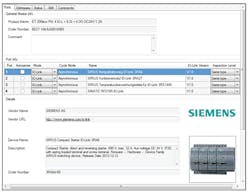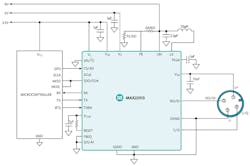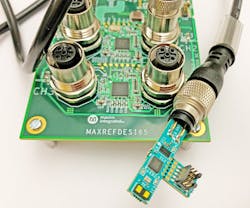There’s so much hype surrounding the Internet of Things (IoT) that I have become a bit of a skeptic. I think it’s stupid that my Samsung refrigerator has Wi-Fi so it can communicate with my smart electric meter. I don’t want my 200-W refrigerator turning off during peak usage times to save me a few cents of electricity. I want a box of cold that ensures I have the best food safety.
An IoT Skeptic
I was equally skeptical of the mesh radio networks that were supposed to connect factory IoT nodes. Any musician knows that anything with a battery is sure to run out just when you need it most. I have seen estimates that a battery replacement in a factory can cost around $150. And if the most-used mesh node in your factory runs low of battery power, then you might as well replace all of the batteries in all of the nodes.
Worse yet, most every system in a factory is “mission critical.” You would not want any data loss when a battery dies, and it’s just as bad to lose data while you are replacing the batteries. Thankfully, there are companies that ignore the IoT hype and have quietly and consistently implemented industrial electronic systems that are providing real benefits on the factory floor. Most of those systems are powered by a wire, not a battery.
Factory IoT is Real and Working
Suhel Dhanani, director of business development for the industrial and healthcare business unit at Maxim Integrated, said, “Industrial IoT is real and is being implemented across a range of industries. Industrial IoT benefits include process production optimization and reduced maintenance costs. These benefits drive real investment in the industrial IoT infrastructure because the payoffs are so measurable and immediate.” He noted the industrial sector accounts for about a third of Maxim Integrated's business.
IoT in the factory pushes intelligence down to the “edge,” the sensor and actuator level. That means you can have maintenance and debugging functions right at the node, as opposed to a central authority. I first saw this at Echelon, a company that makes control systems for smart buildings. Some of its systems communicate over ac power lines already in the building. Since the available bandwidth is low, it does not make sense to have, say, a dumb thermostat that’s constantly reporting the temperature to a central controller. Instead, they put intelligence in the thermostat, so it just transmits when it’s out of range. This minimizes the traffic on the ac power bus, allowing for more sensors and larger systems with fewer data collisions.
Maxim’s Dhanani depicted the great progress Maxim has achieved in reducing the size and power consumption of industrial controllers (Fig. 1). Maxim architected an industrial programmable logic controller (PLC) back in 2014 that used 75 ICs and took up 540cc of volume. In 2016, by integrating functions, Maxim had reduced the IC count to 28, and the volume to 167cc. In 2018, the entire PLC was integrated into one printed circuit board (PCB) with 12 ICs that take up 12cc of space.
1. Industrial PLCs are getting radically smaller and consume much less power. (Courtesy of Maxim Integrated)
Dhanani also mentioned, “As we start integrating different functions in products, we have also started developing innovative packaging technologies that allow us to integrate discrete functions such as an inductor and even transformers in a single package with the IC.”
I first saw this when my pal Roger Beeston went to work at Enpirion. They make power modules that have inductors built inside the package. They got bought by Altera, which was then gobbled up by Intel. The Linear Technology product line at Analog Devices and the Intersil product line at Renesas also feature modules with inductors and other discretes integrated inside the package.
The IO-Link Standard
One standard for factory IoT is the IO-Link (Fig. 2). It’s administered by the same group that does PROFIBUS (Process Field Bus), which was first proposed in 1989 by BMBF (German department of education and research). It was later adopted by Siemens and then standardized. Similarly, the IO-Link standard is administered by a consortium of industrial companies.
2. The IO-Link standard connects sensors and actuators to a factory fieldbus or industrial internet network. (Courtesy of IO-Link Company Community)
IO-Link is a short-haul communications and power standard with a 20-meter maximum length of unshielded cable. The IO-Link master sends 24-V dc power to devices up to 200 mA. The digital data is also at 24 V, which lets the noise immunity use unshielded cable. The IO-Link standard allows for three data rates, from 4.8 kbaud, to 38.4 kbaud, to a maximum of 230.4 kbaud. An IO-Link device such as a sensor or actuator can only have one data rate, while the IO-Link master will try to communicate at the fastest rate and then step down the speed until it establishes communication.
One benefit of the IO-Link standard is a data file in the devices that identify many parameters and other information (Fig. 3). The IODD (IO Device Description) file helps system integration by storing communication properties; device parameters with value range and default value, identification, process, and diagnostic data; device data; a text description; an illustration of the device; and even a logo of the manufacturer.
3. The IO-Link standard specifies a file inside every device that gives complete information about the device. (Courtesy of IO-Link Company Community)
An IO-Link Transceiver Chip
To support IO-Link, Maxim Integrated brought out the MAX22513 (Fig. 4). Priced at $3.75 in 1000-piece quantities, it’s a transceiver for use in an IO-Link device, as opposed to a master node. The part draws on the serial interface expertise that made Maxim famous, its RS-232 and RS-485 chips, and combines it with the company’s expertise in buck and linear regulators.
4. The MAX22513 is an IO-Link transceiver that also includes a buck and two linear regulators. (Courtesy of Maxim Integrated)
The part can use its buck regulator to put out any voltage from 2.5 to 12 V at 300 mA. The internal linear regulators are able to make 5 and 3.3 V. You can power the linear regulators from the buck-regulator output or directly from the nominal 24-V input to the IC. The linear regulator needs at least 6-V input for headroom on the 5-V supply. Note the linear regulators’ output can vary between 4.75 and 5.25 V and 3.1 and 3.3 V, so don’t expect to use them as a reference voltage.
You can set up the buck regulator to switch at either 921 kHz or 1.229 MHz. The part also provides for a 7% spread-spectrum jitter to help you pass regulatory RF emission standards. The transceiver’s power pin can stand a continuous overvoltage of ±36 V, with a 100-µs rating of −52 to +65 V. It features ±1-kV surge protection as well as hot-plug and reverse-polarity protection. The IC is characterized at a −40 to 125°C temperature range.
To help get you started with your factory IoT project, Maxim offers the MAXREFDES171# reference design (Fig. 5). You can buy it built and tested for $65, or download the design files and make it yourself. It implements a laser time-of-flight (ToF) distance sensor. For the microcontroller, the design uses a Maxim MAX32660, based on an Arm Cortex-M4 with a floating point unit (FPU). The laser ranging sensor is a VL53L1X from STMicro. Ranging up to 400 cm is possible, and there’s support for SPI, UART, and I2C communications protocols. The sensor operates over −20 to 80°C.
5. To help develop IO-Link applications, you can get a MAXREFDES171# reference design that has the MAX22513, an Arm-core microcontroller, and a laser time-of-flight distance sensor. (Courtesy of Maxim Integrated)
The MAXREFDES171# works as an IO-Link device. This means you have to connect it to an IO-Link master that’s powered by 24 V dc. If you want to develop or customize the master controller, you can start with the Maxim MAXREFDES165# four-channel IO-Link master reference design (Fig. 6).
6. Maxim also offers the MAXREFDES165# that implements a four-channel IO-Link master controller, here shown with the MAXREFDES171#. (Courtesy of Maxim Integrated)
Factory IoT Pays Off
Maxim’s Dhanani gave an example of Industrial IoT that was highlighted in Enterprise IoT Insights magazine. In this case study, they describe how Intel monitored the health of fan filter units (FFUs) in its semiconductor production facilities. FFUs filter and clean the air inside industrial machines. They are everywhere on the factory floor. Intel placed an accelerometer at the top of each FFU to measure variations in the fan’s function to monitor the variations. If there are any anomalous vibrations, the intelligent sensor sends a warning to the maintenance department of a potential failure.
Just recently, I received a press release about IoT for connected trash compactors. I thought this was more hype for some home-of-the-future. Reading more carefully, I noted that it was industrial trash compactors developed by Harmony Enterprises using software from New Boundary Technologies and hardware from Eurotech.
Look for IoT to make a lot of sense in industrial applications. Similarly, you can expect to see self-driving long-haul trucks before you can buy a self-driving car. It’s great the industrial market leads the way, since industry demands that products make financial sense. And they will ensure that all of the bugs get worked out before the technology goes into consumer products.

